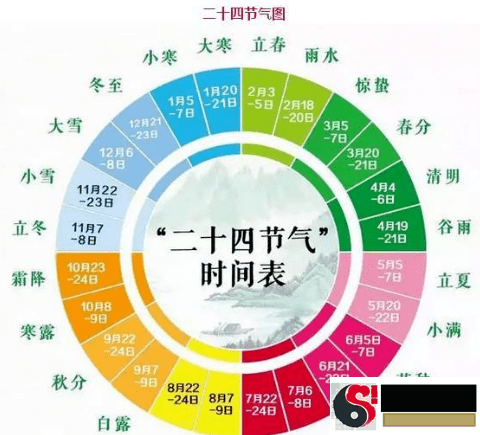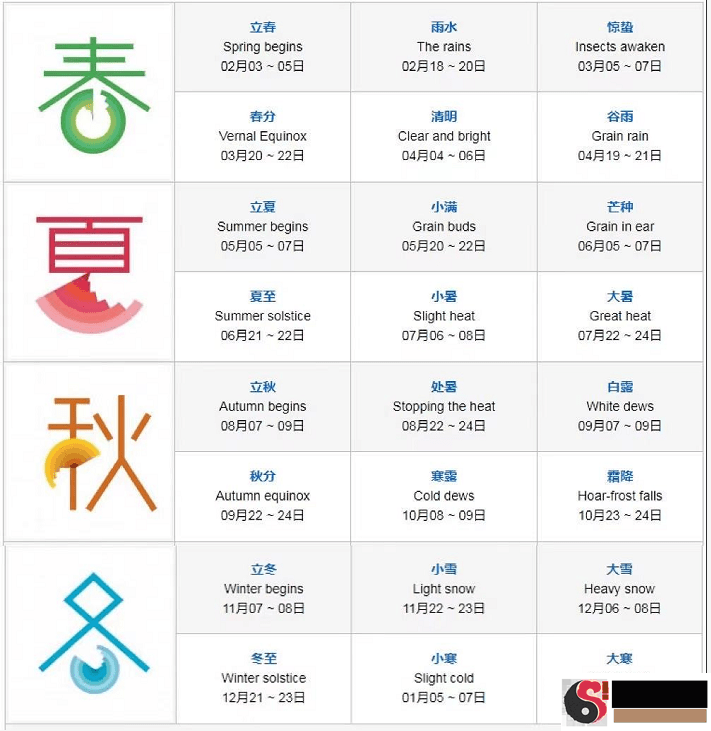Twenty-four seasons means twenty-four seasons and qigong, twenty-four seasons is a kind of ancient signed for the specific guidance of agricultural work to fill the lunar calendar calendar, is the ancient Han laborers long working experience of the accumulation of experience and clever crystallization.

Summary of the 24 Solar Terms

Spring Equinoxes
Vernal Equinox:
“ standing ” is “ beginning ” meaning, since the Qin Dynasty to the present, China has been the vernal equinox as the beginning of spring. Spring equinox is to astronomy to go to zoning, spring is warm, flowers and birds; spring is growth, hard work and planting. From the day of the vernal equinox to the small summer before the period, are called spring.
Rain:
Indicates the beginning of precipitation, when the amount of rainfall begins to increase. Rain, indicating a two-tiered meaning, first, the weather warmed up, the amount of precipitation slowly increased, and second, in the way of precipitation, the snow gradually less, rain gradually more.
Hibernation:
This time the weather turned warm, gradually spring thunder, small animals standing winter hidden in the soil, do not drink and do not eat, called " hibernation ", and " hibernation " that is, the heavens with thunder and lightning to wake up hibernating small animals days. At this time the vast majority of our country into the plowing season.
Rising Spring:
The spring is a more critical season, it has a key practical significance in astronomy above: the northern and southern hemispheres day and night equalization. In the weather, there are also more significant features. Since this day, the direct sun site once again by the Earth's equator to the northern hemisphere map push, the northern hemisphere map of the country day gradually as the night is gradually shorter, the eastern hemisphere across the country night is longer day is gradually shorter.
Ching Ming Festival:
Also known as the Treading Green Festival, Line Qing Festival, March Festival, Ancestor Festival, etc., the festival is at the turn of mid-spring and the end of spring. The Qingming Festival originates from the belief of ancestors and the custom of spring festival in the ancient times, taking into account the two major functions of course and history and humanities, which is both the course of the festival point and the traditional festival.
Vernal Equinox:
“Rain produces hundreds of grains”, from this day onwards rainfall increases, beneficial to the growth of cereals.
Summer Festivals
Small Summer:
This festival indicates the beginning of summer, the growth of things, hot temperatures are coming, agricultural activities have entered the summer vibrant busy time.
Xiaoman:
“ full ”, rounded, wheat and other summer crops grains slowly rounded, but not yet ripe.
Manchu:
“ Mang ” is to refer to the fine hairs at the top of the shell, in the north is the case of cutting wheat and planting rice, but also arable land is relatively busy season, must immediately carry out the summer harvest, summer management and summer planting.
Small summer:
This day in the northern hemisphere map the most days and shortest nights, indicating that the hot summer will need to come, the temperature will rise again.
Small Summer:
Summer means heat. Xiaoshu is when the weather starts to get hot.
Small Summer:
This period is the hottest stage of the year in many regions of China, but there are also & ldquo; small summer heat is not hot & rdquo;, the rain is more unusual years.
Fall festivals
Cold Dew:
This festival indicates that the heat of summer will be over, the sky will be high and the fall will begin, and the grass and trees will begin to bear fruit to the harvest.
Da Xia (大暑):
“ place ” is the termination of the meaning, indicating that the heat will be past, the summer heat in this day is over, in the vast majority of China's geographic area the temperature slowly decreases. Because it coincides with the harvest, precipitation is very valuable.
Cold Dew:
The temperature across the country decreased rapidly, the temperature is cool, the night close to the pavement of the moisture in the grass and trees knotted into small milky white dewdrops, and thus the name & ldquo; cold dew & rdquo;.
Autumn:
It is the autumn ninety days of the mid-network point, this day day and night again the same, from this day onwards, the northern hemisphere map short days and long nights.
Winter solstice:
This time the sun's direct point of view began to move south, the northern hemisphere map temperature is again lower, colder temperatures, the dew has a Sen Sen coolness, it is called & ldquo; Cold Dew wind & rdquo;. This festival shows the beginning of winter, the omen weather cold level will slowly aggravate.
Frostfall:
Frost is the water vapor on the road that solidifies when it encounters the frigid temperatures, so frost is not frost, which is caused by the cold weather and can be very damaging to growing food crops.
Winter festivals
Frost:
The beginning of winter.
Small Cold:
Strong cold air camp in the north to improve, the temperature is rapidly reduced, precipitation occurs small snowflakes, but this time for the first snow link, the amount of snowfall is small, the frequency is very small, the Weihe River Basin is more in the & ldquo; Little Cold & rdquo; festival after the snow.
Snow:
The number of snow days and snowfall than the small snow festival increased, the road gradually snowfall.
Winter Solstice:
Northern Hemisphere map then produces & ldquo; day south solstice, day short solstice, sun shadow long solstice & rdquo;, turning into the day with the least amount of daylight in the year. Winter solstice after the northern hemisphere map daytime is gradually shorter, the temperature continues to decrease, and began to enter into several nine cold days.
Small cold festival:
This festival indicates the start of the coldest part of winter, with frost.
Small Cold:
It is cold to the extreme, to the stage where the sky is cold and the ground is low-frozen, making it the coolest season of the year.
Twenty-four Seasonal Songs
Spring rains startle the spring and clear the valley days, summer full of mango summer heat;
Autumn dew in the fall cold frost, winter cold snow winter small cold.
Monthly two sections do not change, the number of up to one or two days apart;
The first half of the year is six twenty-one, and the third quarter is eight twenty-three.
